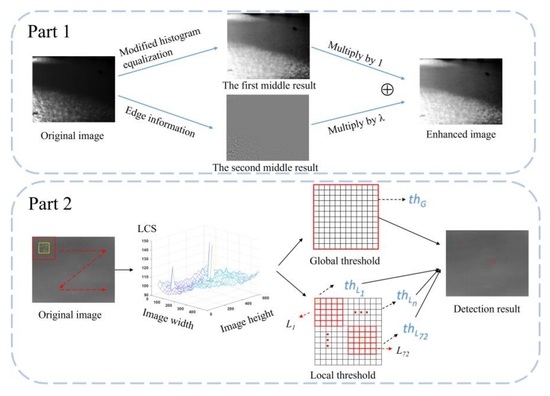An Effective Method of Infrared Maritime Target Enhancement and Detection with Multiple Maritime Scene
Abstract
:1. Introduction
- (1)
- Proposing the effective image pre-processing algorithm for the backlight maritime scene, the pre-processing result’s output can be used as the input data source of the image target’s detection algorithm, which can improve the DR of image’s infrared maritime true target.
- (2)
- Study the mathematical model of LCS for the suspected target with the property of both positive contrast and negative contrast. By contrast, the conventional LCM algorithm is only fit for detecting the target with the property of positive contrast. Moreover, we establish the suspected target detection mechanism with the global and local threshold selection strategy.
- (3)
- Establish the structure of image target detection unit with double scale, which approaches the “from bottom to top” mechanism of VAM. The maximum saliency map of the integrated two scales in the TDU can determine the approximate target area, and the source scale from the maximum saliency map can locate the target with high precision. Moreover, it is highly noted that the detection algorithm based on LCS establishment with double scale be able to have more opportunities to find the true targets, and the concerned parameters can be selected adaptively according to the size definition of a small target from SPIE.
2. Materials and Methods
2.1. Equipment and Image Acquisition Manner for Infrared Maritime Target
2.2. The Proposed Pre-Processing MHEEF Algorithm
2.2.1. Obtain the New Histogram and New Histogram Equalization
2.2.2. Edge Information Quantification and Fusion into the First Middle Result
2.2.3. Final Enhancement Result of Pre-Processing Algorithm
2.3. The Proposed LCMDSM Detection Algorithm
2.3.1. The Structure of TDU with Double Scale
2.3.2. The Mathematical Model for Target Detection with Positive Contrast and Negative Contrast
2.3.3. Threshold Selection Strategy for LCS and Target Rectangle Output
3. Results
3.1. The Contribution of the Pre-Processing MHEEF Algorithm
3.2. The Objective Image Quality Assessment of Enhancement Result
3.3. The Target Detection Results of LCMDSM Algorithm and Compared Algorithms
4. Discussion
4.1. The Performance Analysis of the Proposed Algorithm
4.2. The Challenge and Effective Measure in the Field of Infrared Maritime Target Detection
5. Conclusions
Author Contributions
Funding
Data Availability Statement
Acknowledgments
Conflicts of Interest
References
- Zhang, M.; Dong, L.L.; Zheng, H.; Xu, W.H. Infrared maritime small target detection based on edge and local intensity features. Infrared Phys. Technol. 2021, 119, 103940. [Google Scholar] [CrossRef]
- Wang, B.; Benli, E.; Motai, Y.; Dong, L.; Xu, W. Robust detection of infrared maritime targets for autonomous navigation. IEEE Trans. Intell. Veh. 2020, 5, 635–648. [Google Scholar] [CrossRef]
- Teng, S.Y.; Su, N.J.; Lee, M.A.; Lan, K.W.; Chang, Y.; Weng, J.S.; Wang, Y.C.; Sihombing, R.I.; Vayghan, A.H. Modeling the habitat distribution of Acanthopagrus schlegelii in the coastal waters of the Eastern Taiwan strait using MAXENT with fishery and remote sensing data. J. Mar. Sci. Eng. 2021, 9, 1442. [Google Scholar] [CrossRef]
- Chang, L.; Chen, Y.T.; Wu, M.C.; Alkhaleefah, M.; Chang, Y.L. U-Net for Taiwan Shoreline Detection from SAR Images. Remote Sens. 2022, 14, 5135. [Google Scholar] [CrossRef]
- Wu, L.; Fang, S.H.; Ma, Y.; Fan, F.; Huang, J. Infrared small target detection based on gray intensity descent and local gradient watershed. Infrared Phys. Technol. 2022, 123, 104171. [Google Scholar] [CrossRef]
- Lu, R.; Yang, X.; Jing, X.; Chen, L.; Fan, J.; Li, W.; Li, D. Infrared small target detection based on local hypergraph dissimilarity measure. IEEE Geosci. Remote Sens. Lett. 2020, 19, 7000405. [Google Scholar] [CrossRef]
- Lu, R.; Yang, X.; Li, W.; Fan, J.; Li, D.; Jing, X. Robust infrared small target detection via multidirectional derivative-based weighted contrast measure. IEEE Geosci. Remote Sens. Lett. 2020, 19, 7000105. [Google Scholar] [CrossRef]
- Gonzalez, R.C.; Wints, P. Digital Image Processing, 2nd ed.; Addison-Wesley Publishing: Boston, MA, USA, 1987. [Google Scholar]
- Zhang, W.D.; Zhuang, P.X.; Sun, H.H.; Li, G.H.; Kwong, S.; Li, C.Y. Underwater image enhancement via minimal color loss and locally adaptive contrast enhancement. IEEE Trans. Image Process. 2022, 31, 3997–4010. [Google Scholar] [CrossRef] [PubMed]
- Zhang, W.D.; Jin, S.L.; Zhuang, P.X.; Liang, Z.; Li, C.Y. Underwater image enhancement via piecewise color correction and dual prior optimized contrast enhancement. IEEE Signal Proc. Let. 2023, 30, 229–233. [Google Scholar] [CrossRef]
- Chen, S.D.; Ramli, R. Minimum mean brightness error bi-histogram equalization in contrast enhancement. IEEE Trans. Broadcast Telev. Receiv. 2003, 49, 1310–1319. [Google Scholar] [CrossRef]
- Singh, K.; Vishwakarma, D.K.; Walia, G.S.; Kapoor, R. Contrast enhancement via texture region based histogram equalization. J. Mod. Opt. 2016, 63, 1444–1450. [Google Scholar] [CrossRef]
- Wu, X.; Liu, X.; Hiramatsu, K.; Kashino, K. Contrast-accumulated histogram equalization for image enhancement. In Proceedings of the IEEE International Conference on Image Processing, Beijing, China, 17–20 September 2017. [Google Scholar]
- Parihar, A.S.; Verma, O.P. Contrast enhancement using entropy-based dynamic sub-histogram equalization. IET Image Process. 2016, 10, 799–808. [Google Scholar] [CrossRef]
- Pan, X.; Cheng, J.; Hou, F.; Lan, R.; Lu, C.; Li, L.; Feng, Z.; Wang, H.; Liang, C.; Liu, Z. SMILE: Cost-sensitive multi-task learning for nuclear segmentation and classification with imbalanced annotations. Med. Image Anal. 2023, 88, 102867. [Google Scholar] [CrossRef] [PubMed]
- Pan, X.; Lin, H.; Han, C.; Feng, Z.; Wang, Y.; Lin, J.; Qiu, B.; Yan, L.; Li, B.; Xu, Z.; et al. Computerized tumor-infiltrating lymphocytes density score predicts survival of patients with resectable lung adenocarcinoma. iScience 2022, 25, 105605. [Google Scholar] [CrossRef] [PubMed]
- Zhu, H.; Ni, H.; Liu, S.; Xu, G.; Deng, L. Tnlrs: Target-aware non-local low-rank modeling with saliency filtering regularization for infrared small target detection. IEEE Trans. Image Process. 2020, 29, 9546–9558. [Google Scholar] [CrossRef] [PubMed]
- Hsieh, T.H.; Chou, C.L.; Lan, Y.P.; Ting, P.H.; Lin, C.T. Fast and robust infrared image small target detection based on the convolution of layered gradient kernel. IEEE Access 2021, 9, 94889–94900. [Google Scholar] [CrossRef]
- Tom, V.T.; Peli, T.; Leung, M.; Bondaryk, J.E. Morphology-based algorithm for point target detection in infrared backgrounds. Proc. SPIE 1993, 1954, 2–11. [Google Scholar] [CrossRef]
- Deshpande, S.D.; Er, M.H.; Ronda, V.; Chan, P. Max-mean and max-median filters for detection of small-targets. Proc. SPIE 1999, 3809, 74–83. [Google Scholar] [CrossRef]
- Barnett, J. Statistical analysis of median subtraction filtering with application to point target detection in infrared backgrounds. Proc. SPIE 1989, 1050, 10–15. [Google Scholar] [CrossRef]
- Jia, L.; Rao, P.; Zhang, Y.; Su, Y.; Chen, X. Low-SNR infrared point target detection and tracking via saliency-guided double-stage particle filter. Sensors 2022, 22, 2791. [Google Scholar] [CrossRef]
- Tang, Y.; Xiong, K.; Wang, C. Fast infrared small target detection based on global contrast measure using dilate operation. IEEE Geosci. Remote Sens. Lett. 2023, 20, 8000105. [Google Scholar] [CrossRef]
- Chan, Y.T. Maritime filtering for images and videos. Signal Process Image Commun. 2021, 99, 116477. [Google Scholar] [CrossRef]
- Chen, L.P.; Li, H.; Wei, Y.T.; Xia, T.; Tang, Y.Y. A local contrast method for small infrared target detection. IEEE Trans. Geosci. Remote Sens. 2014, 52, 574–584. [Google Scholar] [CrossRef]
- Wei, Y.; You, X.; Li, H. Multiscale patch-based contrast measure for small infrared target detection. Pattern Recognit. 2016, 58, 216–226. [Google Scholar] [CrossRef]
- Cui, H.X.; Li, L.Y.; Liu, X.; Su, X.F.; Chen, F.S. Infrared small target detection based on weighted three-layer window local contrast. IEEE Geosci. Remote Sens. 2022, 19, 7505705. [Google Scholar] [CrossRef]
- Yang, P.; Dong, L.L.; Xu, W.H. Infrared small maritime target detection based on integrated target saliency measure. IEEE J. Sel. Top. Appl. Earth Obs. Remote Sens. 2021, 14, 2369–2386. [Google Scholar] [CrossRef]
- Ren, L.; Pan, Z.B.; Ni, Y. Double layer local contrast measure and multi-directional gradient comparison for small infrared target detection. Optik 2022, 258, 16889. [Google Scholar] [CrossRef]
- Han, J.; Liang, K.; Zhou, B.; Zhu, X.Y.; Zhao, J.; Zhao, L.L. Infrared small target detection utilizing the multiscale relative local contrast measure. IEEE Geosci. Remote Sens. 2018, 15, 612–616. [Google Scholar] [CrossRef]
- Chan, Y.T. Comprehensive comparative evaluation of background subtraction algorithms in open sea environments. Comput. Vis. Image Und. 2021, 202, 103101. [Google Scholar] [CrossRef]
- Deng, H.; Sun, X.; Liu, M.; Ye, C.; Zhou, X. Infrared small-target detection using multiscale gray difference weighted image entropy. IEEE Trans. Aerosp. Electron Syst. 2016, 52, 60–72. [Google Scholar] [CrossRef]
- Aghaziyarati, S.; Moradi, S.; Talebi, H. Small infrared target detection using absolute average difference weighted by cumulative directional derivatives. Infrared Phys. Technol. 2019, 101, 78–87. [Google Scholar] [CrossRef]
- Moradi, S.; Moallem, P.; Sabahi, M.F. Fast and robust small infrared target detection using absolute directional mean difference algorithm. Signal Process. 2020, 177, 107727. [Google Scholar] [CrossRef]
- Gao, C.; Meng, D.; Yang, Y.; Wang, Y.; Zhou, X.; Hauptmann, A.G. Infrared patch-image model for small target detection in a single image. IEEE Trans. Image Process. 2013, 22, 4996–5009. [Google Scholar] [CrossRef] [PubMed]
- Zhang, L.; Peng, L.; Zhang, T.; Cao, S.; Peng, Z. Infrared small target detection via non-convex rank approximation minimization joint l2,1 norm. Remote Sens. 2018, 10, 1821. [Google Scholar] [CrossRef] [Green Version]
- Kong, X.; Yang, C.; Cao, S.; Li, C.; Peng, Z. Infrared small target detection via nonconvex tensor fibered rank approximation. IEEE Trans. Geosci. Remote Sens. 2021, 60, 5000321. [Google Scholar] [CrossRef]
- Zhang, Z.; Ding, C.; Gao, Z.; Xie, C. ANLPT: Self-Adaptive and Non-Local Patch-Tensor Model for Infrared Small Target Detection. Remote Sens. 2023, 15, 1021. [Google Scholar] [CrossRef]
- Ding, C.; Pan, X.P.; Gao, X.Y.; Ning, L.H.; Wu, Z.K. Three adaptive sub-histograms equalization algorithm for maritime image enhancement. IEEE Access 2020, 8, 147983–147994. [Google Scholar] [CrossRef]
- Cao, Q.; Shi, Z.; Wang, R.; Wang, P.; Yao, S. A brightness-preserving two-dimensional histogram equalization method based on two-level segmentation. Multimed. Tools Appl. 2020, 79, 27091–27114. [Google Scholar] [CrossRef]
- Huang, S.; Peng, Z.; Wang, Z.; Wang, X.; Li, M. Infrared small target detection by density peaks searching and maximum-gray region growing. IEEE Geosci. Remote Sens. Lett. 2019, 16, 1919–1923. [Google Scholar] [CrossRef]
- Agaian, S.S.; Silver, B.; Panetta, K.A. Transform coefficient histogram-based image enhancement algorithms using contrast entropy. IEEE T. Image Process. 2007, 16, 741–758. [Google Scholar] [CrossRef]
- Qin, Y.; Bruzzone, L.; Gao, C.; Li, B. Infrared small target detection based on facet kernel and random walker. IEEE Trans. Geosci. Remote Sens. 2019, 57, 7104–7118. [Google Scholar] [CrossRef]
- Zhang, H.; Zhang, L.; Yuan, D.; Chen, H. Infrared small target detection based on local intensity and gradient properties. Infrared Phys. Technol. 2018, 89, 88–96. [Google Scholar] [CrossRef]
- Jaskowiak, P.A.; Costa, I.G.; Campello, R.J.G.B. The area under the ROC curve as a measure of clustering quality. Data Min. Knowl. Disc. 2022, 36, 1219–1245. [Google Scholar] [CrossRef]
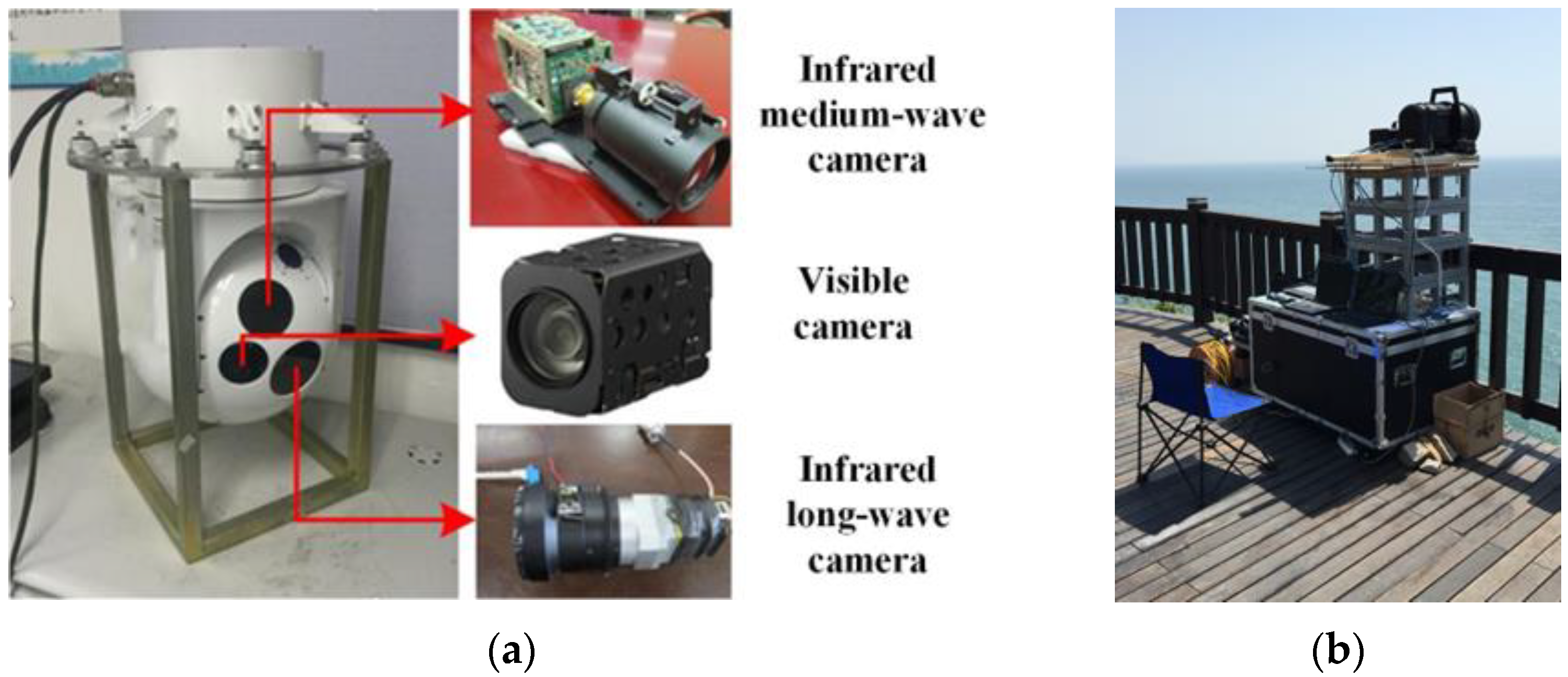


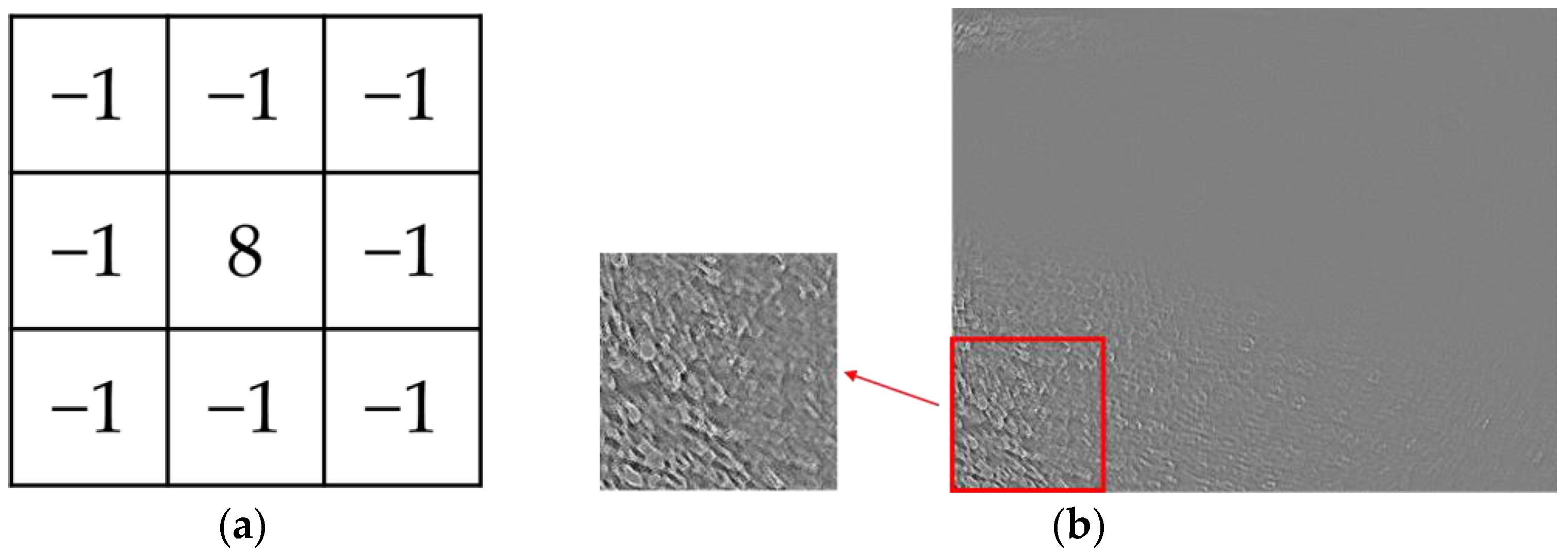





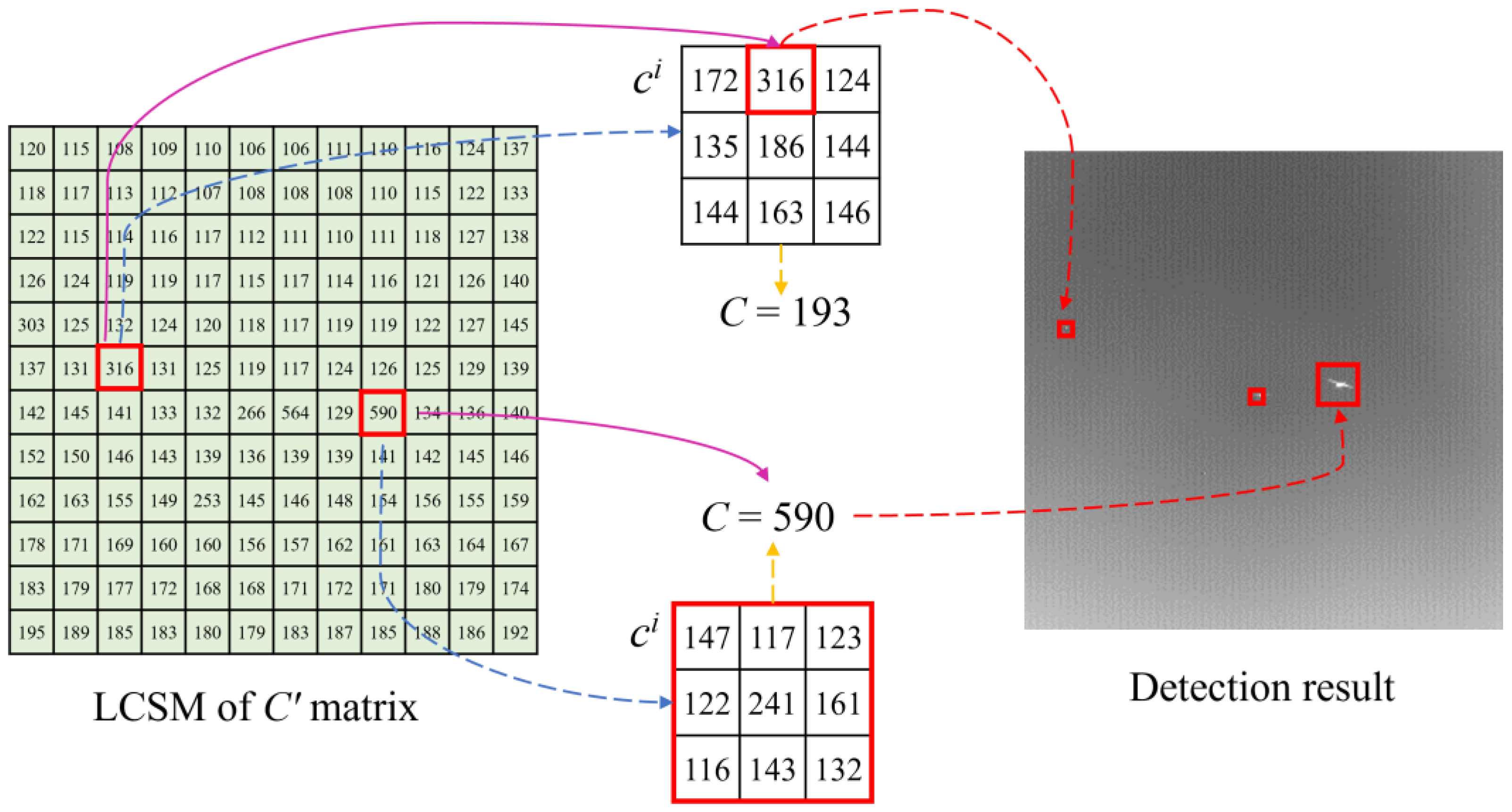





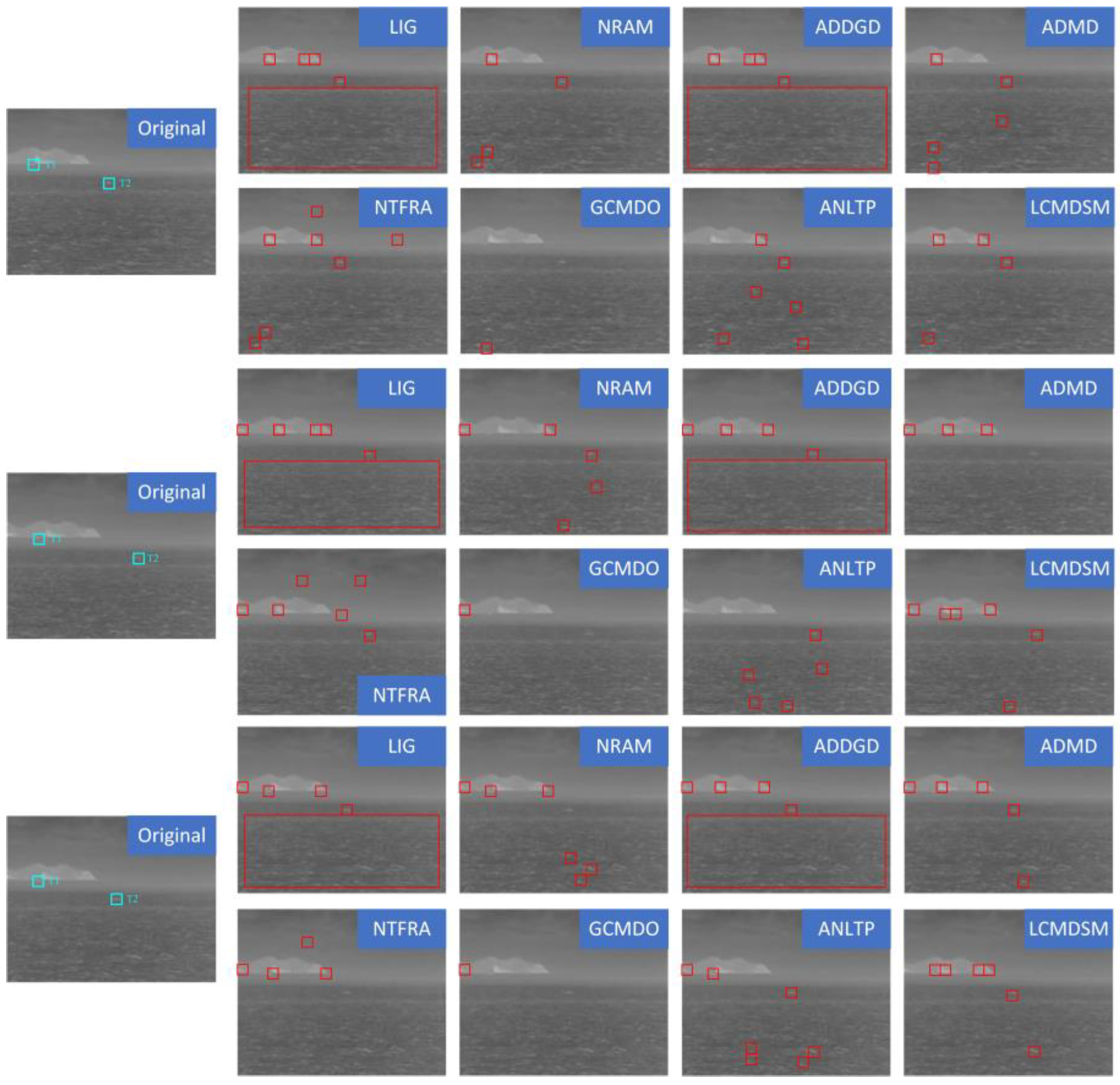
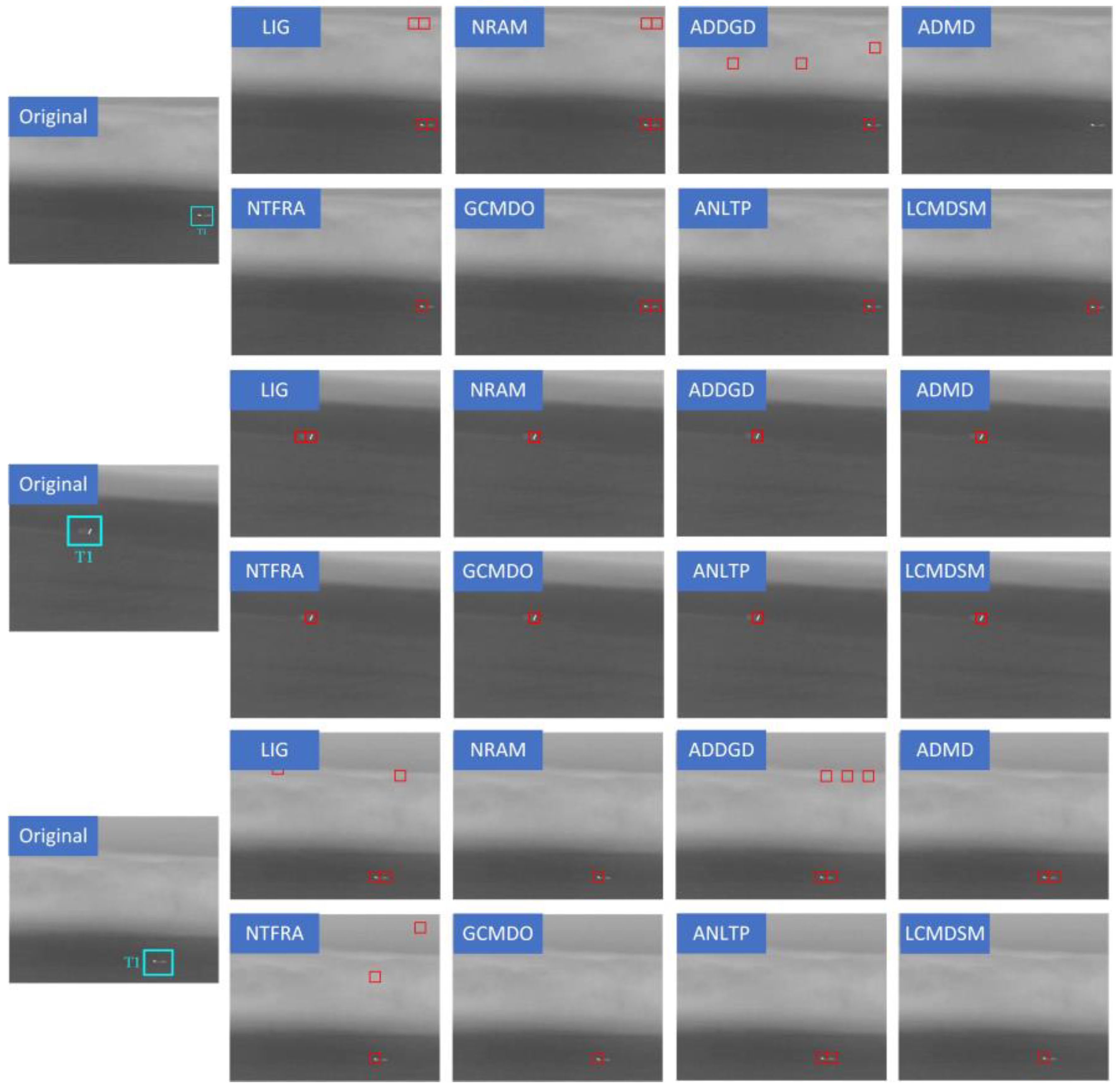
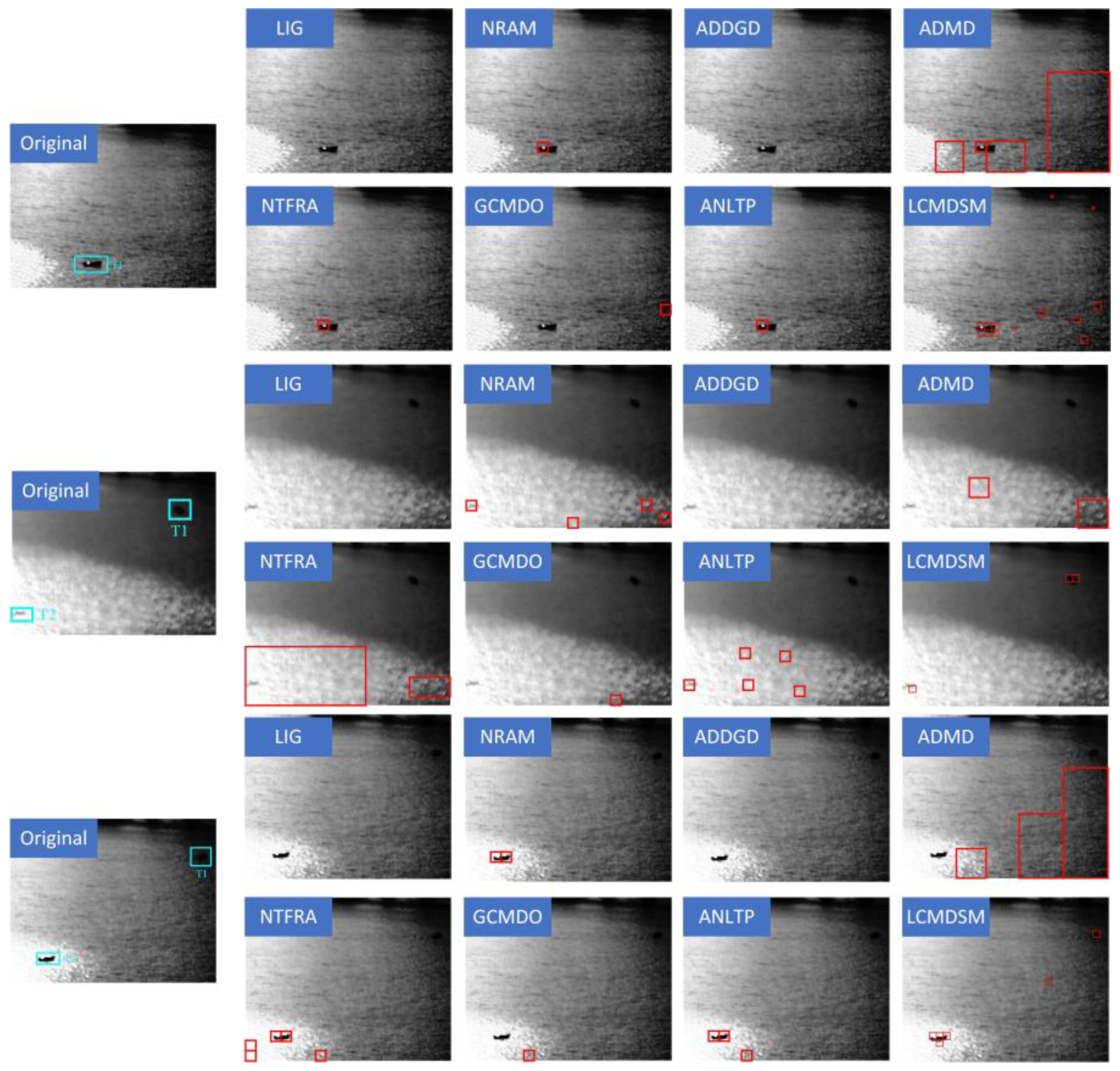


| Algorithm LCMDSM |
| Input: IR image named by I. (height: M; width: N) Output: position, width and height of the target rectangle in I. Initial Definition: parameter k; w1←floor((M × N × 0.0015)^0.5); w0←w1/3; C←array(M/w1, N/w1); ←array(M/w1, N/w1); A: Locating the central point of TDU, traversing the entire image and calculating the LCSM respectively A1: for i = 1: w1: M A2: for j = 1: w1: N do A3: Obtaining B,T,t1,t2,…and t9 region from I by i and j A4: Calculating the LCS of C, c1,2,…9 and getting the maximum result as C’ A5: end for A6: end for A7: (ii,jj) ← find(C’ > thG || C’ > thL) A8: Store the position of suspected target with (ii,jj) and the total number of targets with N. A9: Store the maximum source scale from C, c1,2,…9. B: Outputting the red rectangle of suspected target’s region B1: for i = 1:N B2: Locating the central point from (ii,jj) and choosing the suitable width and height from C or ci. B3: end for |
| Figure | AG | EME | Figure | AG | EME |
|---|---|---|---|---|---|
| Figure 2a | 1.11 | 1.30 | Figure 2b | 0.86 | 1.95 |
| Figure 13a | 1.67 | 1.86 | Figure 14a | 2.84 | 2.79 |
| Figure 13b | 1.46 | 1.71 | Figure 14b | 1.22 | 2.72 |
| Figure 13c | 1.33 | 1.82 | Figure 14c | 1.33 | 1.82 |
| Figure 13d | 3.34 | 2.30 | Figure 14d | 4.26 | 3.15 |
| Figure | BSF | SCR | LCG |
|---|---|---|---|
| Figure 2a | / | 0.48 | / |
| Figure 13a | 0.14 | 0.60 | 3.99 |
| Figure 13b | 0.51 | 0.67 | 1.18 |
| Figure 13c | 2.51 | 0.80 | 1.10 |
| Figure 13d | 2.31 | 0.78 | 3.38 |
| Figure 2b | / | 0.32 | / |
| Figure 14a | 0.30 | 1.30 | 5.90 |
| Figure 14b | 0.38 | 0.49 | 1.76 |
| Figure 14c | 0.38 | 0.41 | 1.47 |
| Figure 14d | 1.26 | 1.08 | 5.25 |
| Algorithm | LIG (2018) | NRAM (2018) | ADDGD (2019) | ADMD (2020) | NTFRA (2022) | GCMDO (2023) | ANLPT (2023) | LCMDSM | MHEEF+ LCMDSM |
|---|---|---|---|---|---|---|---|---|---|
| mDR | 87.24% | 93.21% | 88.29% | 89.73% | 83.22% | 82.71% | 85.51% | 98.26% | |
| Time(s) | 3.5081 | 0.6783 | 0.2846 | 0.2762 | 3.356 | 0.0138 | 3.3209 | 0.5256 | 0.5451 |
Disclaimer/Publisher’s Note: The statements, opinions and data contained in all publications are solely those of the individual author(s) and contributor(s) and not of MDPI and/or the editor(s). MDPI and/or the editor(s) disclaim responsibility for any injury to people or property resulting from any ideas, methods, instructions or products referred to in the content. |
© 2023 by the authors. Licensee MDPI, Basel, Switzerland. This article is an open access article distributed under the terms and conditions of the Creative Commons Attribution (CC BY) license (https://creativecommons.org/licenses/by/4.0/).
Share and Cite
Ding, C.; Luo, Z.; Hou, Y.; Chen, S.; Zhang, W. An Effective Method of Infrared Maritime Target Enhancement and Detection with Multiple Maritime Scene. Remote Sens. 2023, 15, 3623. https://doi.org/10.3390/rs15143623
Ding C, Luo Z, Hou Y, Chen S, Zhang W. An Effective Method of Infrared Maritime Target Enhancement and Detection with Multiple Maritime Scene. Remote Sensing. 2023; 15(14):3623. https://doi.org/10.3390/rs15143623
Chicago/Turabian StyleDing, Chang, Zhendong Luo, Yifeng Hou, Siyang Chen, and Weidong Zhang. 2023. "An Effective Method of Infrared Maritime Target Enhancement and Detection with Multiple Maritime Scene" Remote Sensing 15, no. 14: 3623. https://doi.org/10.3390/rs15143623
APA StyleDing, C., Luo, Z., Hou, Y., Chen, S., & Zhang, W. (2023). An Effective Method of Infrared Maritime Target Enhancement and Detection with Multiple Maritime Scene. Remote Sensing, 15(14), 3623. https://doi.org/10.3390/rs15143623





